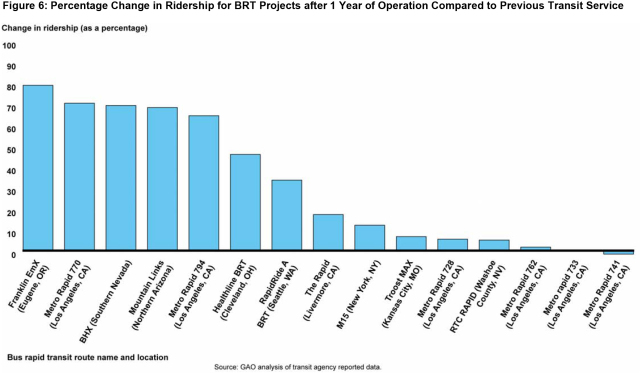Rapid Buses for Rapid Transit?
- Dedicated lanes to increase predictability and reduce travel time;
- Rider amenities in stations or shelters such as weather protection and safety improvements;
- Vehicles that run on alternative fuels or hybrid technology, can carry many riders, and board quickly;
- Service that is faster, more reliable, and more frequent than standard buses—similar to rail transit;
- Efficient fare collection to decrease boarding and travel times;
- Branding to attract riders; and
- Intelligent Transportation Systems to give BRT vehicles priority at intersections, helping to keep them on time.
 (Excerpted from GAO-12-811)
(Excerpted from GAO-12-811)
BRT in the wild
Transit agencies in U.S. cities began pursuing BRT to deal with tight budgets and meet rising demand for public transportation from increasingly urban, car-free populations. In 2012, we looked at the 20 BRT projects that had been completed since 2005 to determine which features they included, and how performance, costs, and benefits stacked up. Some cities take advantage of many features, while others pick and choose for a “BRT-lite” approach. We found elevated stations and ticket machines in Cleveland; dedicated lanes and priority traffic signals in Eugene, Oregon. The Kansas City, Missouri BRT project reported a 35% travel time savings compared to previous transit service. At $36 million, median capital costs for the BRT projects we looked at were about 94% cheaper than rail projects, at $576 million. But full lifecycle comparisons don’t yet exist because BRT is still too new. Transit officials in Cleveland told us that their BRT project attracted development investments of as much as $5 billion. We also found that land values generally rose near BRT projects. However, most officials believed rail had greater potential, and that broader economic conditions seemed to affect development more than BRT projects did. If you build it, will they ride? Most of the projects we examined showed higher ridership than their standard-bus predecessors. (Excerpted from GAO-12-811)
(Excerpted from GAO-12-811)
- Questions on the content of this post? Contact David Wise at wised@gao.gov.
- Comments on GAO’s WatchBlog? Contact blog@gao.gov.

GAO's mission is to provide Congress with fact-based, nonpartisan information that can help improve federal government performance and ensure accountability for the benefit of the American people. GAO launched its WatchBlog in January, 2014, as part of its continuing effort to reach its audiences—Congress and the American people—where they are currently looking for information.
The blog format allows GAO to provide a little more context about its work than it can offer on its other social media platforms. Posts will tie GAO work to current events and the news; show how GAO’s work is affecting agencies or legislation; highlight reports, testimonies, and issue areas where GAO does work; and provide information about GAO itself, among other things.
Please send any feedback on GAO's WatchBlog to blog@gao.gov.
